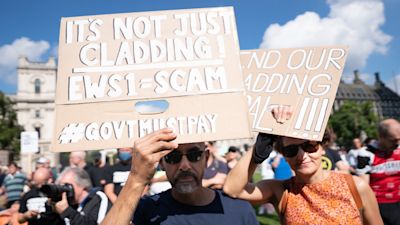Insight
Some UK building companies finally pledge to fix cladding crisis - but is it enough?

Pay up, or we will force you to. That was the warning from Housing Secretary Michael Gove to developers back in January, when he said the construction industry had a moral duty and responsibility to pay to fix the cladding crisis in the wake of the Grenfell Tower tragedy.
After months of negotiations between government and the industry, 36 out 53 construction firms have signed up to a pledge to assess and fix all buildings over 11 metres that have played a role in developing in the last 30 years.
The UK’s biggest listed builders have agreed to stump up £2 billion collectively. Mr Gove has described this as a "victory for leaseholders" and said the government "will do whatever it takes to hold industry to account, and under our new measures there will be nowhere to hide".
However, remember the £2 billion is only half of the £4 billion that ministers previously said was needed to make blocks between 11 and 18 metres safe. The Department for Levelling Up, Housing and Communities said an existing industry levy will be extended and collect another £3bn over the next decade.
It’s nearly five years since the Grenfell Tower fire where 72 people died. Fire engulfed the 24 storey block in London; the external cladding was found to have aided the rapid spread of the blaze. The tragedy exposed decades of systematic regulatory failures.
Today, more than half a million people across the UK are still living in buildings with combustible cladding and a range of other fire safety defects. Many have received huge bills running into tens of thousands of pounds. The battle over who should pay has been a toxic one from the start.
Campaign group UK Cladding Action said Tuesday’s agreement was not a victory "for leaseholders who remain trapped for years as developers wrangle over what to remediate and for how much."
So what happens to those builders who are still refusing to cover the costs of fixing a building safety crisis they helped to create? There will be commercial consequences. Ministers have warned that they will impose tax and legal changes, firms could be barred from government housing funds and the planning process. That would in effect mean they would not be able to build or sell new homes.
There are also questions around who will pay to remediate so called "orphan buildings" where the original developer no longer exists or has ceased trading. Remember too there is a height restriction to all of this - there is still no financial help for those living in buildings under 11 metres with fire safety faults.
Mr Gove, and housing secretaries before him, has also repeatedly said that "no leaseholder living in a building above 11m, will ever face any costs for fixing dangerous cladding".
The reality is thousands of leaseholders are already paying. Insurance bills have rocketed. Service charges have soared. Interim safety measures like 24-hour fire wardens known as "waking watch" cost thousands every week. Many leaseholders have had to stump up to install new fire alarms too. There is no quick fix to this, it will take years to remediate buildings, and in the meantime money is draining away from those who can least afford it.
How did we get here?
In the years that followed the Grenfell tragedy, safety inspections on high rise blocks across the UK have exposed not just problems with combustible cladding, but many other fire safety faults, flammable balconies, defective insulation and missing fire breaks.
The question of who should pay to make buildings safe - flat owners, building owners, developers, the government - has been at the heart of this escalating crisis ever since.
How many buildings are affected?
There are no official figures, and that’s part of the problem. How do you solve a problem if you don’t know the true scale of it? Cladding campaign groups and industry experts estimate 700,000 people are living in flats wrapped in flammable materials. They are facing life-changing bills, and some have already declared bankruptcy. The wider building safety crisis has left approximately three million flats unsellable.
The average cladding bill is around £40,000 per leaseholder. Some people have received bills of more than £200,000, more than they paid for their flats in the first place.
What help is there for leaseholders?
Blocks above 18 metres tall with cladding defects are eligible for the government’s £5.1 billion Building Safety Fund.
That will be paid for, in part, by a 4% levy on residential developers’ profits over the next 10 years.
So far nearly 3,000 blocks have applied, but critics say the process is complex and remediation work has been slow to get going.
For low and mid rise blocks, the government has also said it is launching a new 11-18 million cladding remediation scheme to fund work on buildings where a responsible developer cannot be identified.
For expert analysis on news' biggest stories, listen to the What You Need To Know podcast
What’s been the response from the building sector?
Developers often argue that they met building regulations at the time and should not be liable for the cost of removing unsafe cladding because rules have been tightened post Grenfell.
Stewart Baseley, executive chairman of the Home Builders Federation, said that as well as developers and the government, other parties should now contribute including cladding and insulation manufacturers.
Industry experts have also warned that diverting funding towards cladding work will hamper their ability to build affordable homes.